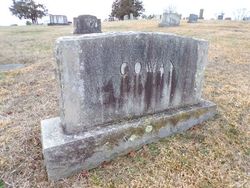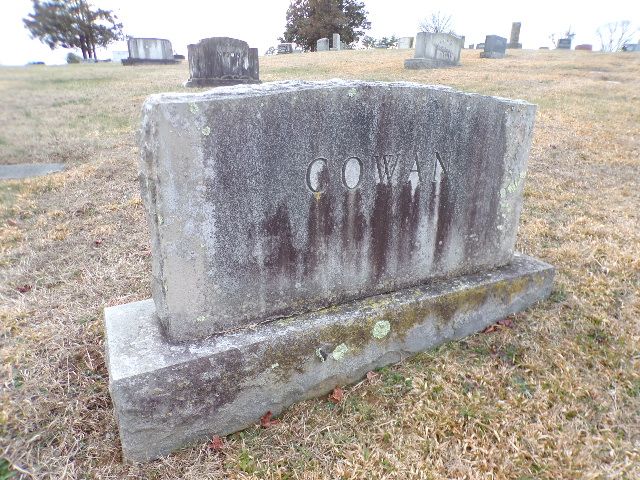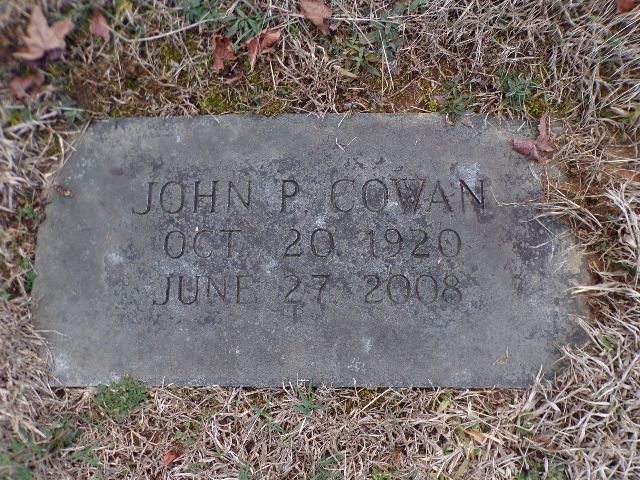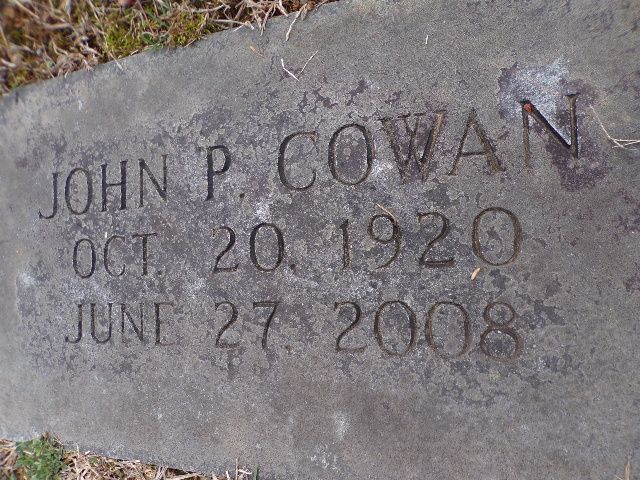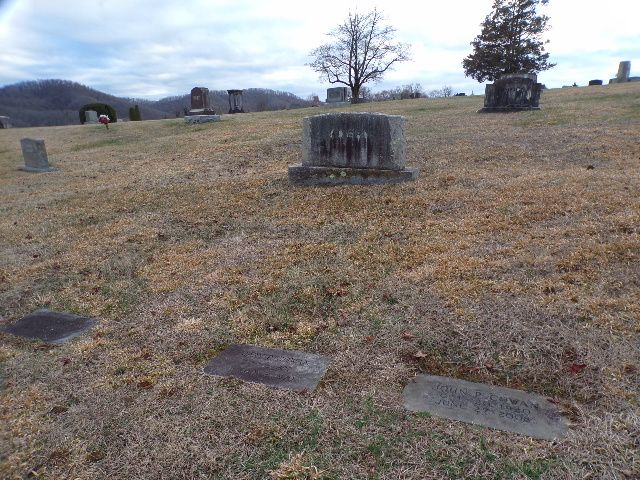Born in Bristol, Tennessee on October, 20, 1920, Mr. Cowan is preceded in death by his parents, Charles F. Cowan and Mary Campbell Pemberton Cowan, his wife, Lois Johnson Cowan, and his only brother, Charles F. Cowan, Jr.
Cowan is survived by two daughters and one son: Kitty Cowan Allen of Baytown, Texas, Mary Jane Cowan and John Pemberton Cowan, Jr., both of Bristol, Tennessee.
Also surviving are five grandchildren: Sara Allen Abbott and husband, Matthew T. Abbott of Arlington, Virginia; Mary Katharine (Kate) Allen Stukenberg and husband, William R. Stukenberg, Evan Cowan Sermas, and Stephanie Elaine Sermas, all of Houston, Texas, and John Marshall Cowan of Bristol, Tennessee. He is also survived by one great-grandson, Benjamin Allen Abbott.
Cowan is also survived by his sister-in-law, Donna Johnson of Montgomery, Texas, and two brothers-in-law, John C. Johnson, also of Montgomery, Texas, and Keith A. Johnson of LaPorte, Texas. Close family members also surviving include Marti Morenings of Bristol, Tennessee, Sydney Allen Seaman and husband, William Seaman of Humble, Texas, their daughter, Grace Elizabeth Seaman, and several nieces, nephews, and cousins.
One of America's premiere wildlife artists, Cowan was a graduate of Pratt Institute in Brooklyn, New York. His paintings have appeared as cover art and illustrations in such magazines as Fortune, Life, Look, Esquire, Sports Afield, Outdoor Life and other national publications.
Cowan was introduced to the beauty of Texas as a young enlisted man in the United States Air Corps originally stationed in Hondo, Texas, during World War II. He was honorably discharged after transfer to Ellington Air Field near Houston, Texas, where he served as an illustrator and began his professional art career.
Two important collections of his art work, The Golden Crescent and John P. Cowan: A Texas Treasure were originally published in 1969 and 1992.
The Texas Legislature named Cowan as 1978-79 Texas State Artist and, over the years, he provided original art for 14 stamp prints: Trout Unlimited (1982), Gulf Coast Conservation (1983-first, 1986, and 1991); Texas Waterfowl (1985, 1988); Texas Turkey Federation (1985, 1988); Arkansas Waterfowl (1986); Louisiana Wildlife Federation (1986); Texas Nongame (1986); Texas Saltwater (1986-first, 1989); and Texas Quail Unlimited (1991).
Cowan was also instrumental in the introduction and enactment of the Texas Red Drum Conservation Act of 1977 – the first significant legislation designed to protect Texas' declining red fish population for future generations of Texas sports fisherman and women.
In 1984, Cowan was selected as one of the top 12 contemporary outdoor artists in America in celebration of the 100th anniversary of Sports Afield magazine.
Cowan received many honors and awards from local, state and national wildlife and conservation associations for his contributions: Houston Ducks Unlimited Sportsman of the Year (1973); National Ducks Unlimited Artist of the Year (1977); Trout Unlimited Artist of the Year (1982); Texas Ducks Unlimited Wetlands Artist of the Year (1985); Houston Ducks Unlimited Sponsor of the Year (1985); National Ducks Unlimited Central Flyaway Artist of the Year (1988); Texas Ducks Unlimited Artist of the Year (1989); Colorado River Environmental Steward Award by the Lower Colorado River Authority (2006); and most recently, the Lifetime Achievement Award in June, 2008, by the Recreational Fishing Alliance of Texas. Later this year, Cowan will be inducted into the new Texas Parks and Wildlife Conservation Hall of Fame in recognition of his many contributions to the protection and conservation of Texas' outdoor resources.
In lieu of usual remembrances, please consider memorial contributions to the Texas Parks & Wildlife Foundation - John P. "Jack" Cowan Redfish Fund, 1901 North Akard, Dallas, Texas 75201-191207 or to the Recreational Fishing Alliance Foundation – John P. "Jack" Cowan Artificial Reef Fund, 15019 Benfer Road, Houston, Texas 77069.
The family will receive friends from 6-8 p.m. on Sunday, June 29, 2008 at Akard Funeral Home, 1912 W. State Street, Bristol, Tennessee 37620. A private family graveside service will be held at Glenwood Cemetery in Bristol, Tennessee, at 10 a.m. on Monday, June 30, 2008.
"He had a lifelong love affair with Texas," said Cowan's daughter, Kitty Allen. "What turned his eye was the very framework that is Texas wildlife and natural beauty."
Allen said she couldn't remember a time when her father wasn't painting or appreciating the outdoors.
"When I was a child, the kids would ask what does your father do and I'd tell them he hunts and fishes," laughed Kitty.
But what Cowan did was much more than just love nature; he actively worked for and supported its conservation.
He was instrumental in the Texas Red Drum Conservation Act of 1977, which was the first legislation enacted to protect Texas' declining Red Drum ("redfish") population.
Originally from Bristol, Tenn., Cowan "fell in love" with Texas after enlisting in the U.S. Air Corps during World War II.
He was stationed in Hondo, Texas, giving him his first glimpse of the state.
After his service, Cowan stayed near Houston, and began his professional art career.
He soon met his future wife, Lois Johnson.
Cowan's draw to Texas reached a pivotal moment during his first winter after a move to Chicago. "It was too cold," said Kitty.
From Chicago, Cowan sent for Lois and the two were married on New Year's Eve 1948.
Afterward, they high-tailed it back to start a family under the warmth of the Southern sun.
Kitty said there is one thing that remained constant: the family always kept close to the water.
Cowan had developed a love and knack for fishing, a fitting sport for someone who so dearly loved to be close to nature.
In the early 1960's, Cowan was introduced to Meredith Long of the now-famous Meredith Long Gallery in Houston.
"He was painting wildlife and I was interested in opening a sporting gallery," said Long. "We started together."
Long said the pair began working side by side.
"We worked together, fished together and hunted together," said Long.
The relationship blossomed into a successful venture for both, putting both their names "on the map."
But in addition to recording wildlife in watercolor paint, Cowan was brainstorming ways to preserve it.
State Parks and Wildlife Commissioner John Parker, another of Cowan's fishing buddies, said Cowan could be credited with the victorious ending to "The Great Redfish War."
It was during a fishing trip in the 1970's with, the late Perry Bass, former Parks and Wildlife Commissioner that Cowan resolved to save the Texas Red Drum, or "Redfish."
"It was a cold day in March," Parker recalled. "They were out fishing down near Rockport and they weren't catching anything."
Bass wondered aloud why nothing seemed to be biting in the once-plentiful waters.
Cowan and Bass decided to approach Cowan's new son-in-law, the late Joe Allen, with a plan of action.
Then a Baytown state representative, Allen agreed to carry the bill, which would put an end to the over-taking of Redfish by the commercial fishing industry.
It passed on first attempt and was signed into law in 1977.
Allen quickly became one of Cowan's close friends and fishing partners.
"Without those three, fishing would probably be stuck in the mud," Parker said.
In 1978, the Texas Legislature named Cowan the Texas State Artist.
"Everybody who saw Jack Cowan's work wanted one of his paintings immediately," Parker said.
The state was no exception and Cowan provided them with artwork for 14 stamps, which were printed between 1982 and 1991.
Throughout the years, Cowan garnered many honors and titles for his artistic skill and habit of donating his works to benefit conservation organizations, including the Eddie V. Gray Wetlands Center in Baytown. The center still proudly displays a print of Canadian Geese flying over the San Jacinto Monument.
Eddie V. Gray himself touts Cowan as "the father of conservation art."
"I met him when he first moved to Baytown," Gray said. "Jack, his daughter Kitty Allen and her husband State Rep. Joe Allen, hosted the first Gala for the Wetlands Center in their home. He was a great person and he was a great outdoorsman. He has a tremendous talent for putting that down in painting."
Cowan eloquently captured Texas' hunting and fishing scene for more than 50 years.
His works appear on the covers of magazines, in the collections of many an art connoisseur and on the walls of museums around the country.
"These are not just duck pictures. They are not just fishing pictures. They are pictures of a habitat," said Long. "It doesn't exist the way it did 20 years ago and it certainly won't be the same 50 years from now."
On June 19, the Texas Chapter of the Recreational Fishing Alliance honored Cowan with a Lifetime Achievement Award.
Cowan could not travel to accept the award, and his daughter, Kitty, accepted on his behalf.
Cowan is considered by many the finest outdoor sporting artist of the 20th century.
Meredith Long put it best when he said, "Jack's work captures a piece of history and a part of the evolution of Texas."
Born in Bristol, Tennessee on October, 20, 1920, Mr. Cowan is preceded in death by his parents, Charles F. Cowan and Mary Campbell Pemberton Cowan, his wife, Lois Johnson Cowan, and his only brother, Charles F. Cowan, Jr.
Cowan is survived by two daughters and one son: Kitty Cowan Allen of Baytown, Texas, Mary Jane Cowan and John Pemberton Cowan, Jr., both of Bristol, Tennessee.
Also surviving are five grandchildren: Sara Allen Abbott and husband, Matthew T. Abbott of Arlington, Virginia; Mary Katharine (Kate) Allen Stukenberg and husband, William R. Stukenberg, Evan Cowan Sermas, and Stephanie Elaine Sermas, all of Houston, Texas, and John Marshall Cowan of Bristol, Tennessee. He is also survived by one great-grandson, Benjamin Allen Abbott.
Cowan is also survived by his sister-in-law, Donna Johnson of Montgomery, Texas, and two brothers-in-law, John C. Johnson, also of Montgomery, Texas, and Keith A. Johnson of LaPorte, Texas. Close family members also surviving include Marti Morenings of Bristol, Tennessee, Sydney Allen Seaman and husband, William Seaman of Humble, Texas, their daughter, Grace Elizabeth Seaman, and several nieces, nephews, and cousins.
One of America's premiere wildlife artists, Cowan was a graduate of Pratt Institute in Brooklyn, New York. His paintings have appeared as cover art and illustrations in such magazines as Fortune, Life, Look, Esquire, Sports Afield, Outdoor Life and other national publications.
Cowan was introduced to the beauty of Texas as a young enlisted man in the United States Air Corps originally stationed in Hondo, Texas, during World War II. He was honorably discharged after transfer to Ellington Air Field near Houston, Texas, where he served as an illustrator and began his professional art career.
Two important collections of his art work, The Golden Crescent and John P. Cowan: A Texas Treasure were originally published in 1969 and 1992.
The Texas Legislature named Cowan as 1978-79 Texas State Artist and, over the years, he provided original art for 14 stamp prints: Trout Unlimited (1982), Gulf Coast Conservation (1983-first, 1986, and 1991); Texas Waterfowl (1985, 1988); Texas Turkey Federation (1985, 1988); Arkansas Waterfowl (1986); Louisiana Wildlife Federation (1986); Texas Nongame (1986); Texas Saltwater (1986-first, 1989); and Texas Quail Unlimited (1991).
Cowan was also instrumental in the introduction and enactment of the Texas Red Drum Conservation Act of 1977 – the first significant legislation designed to protect Texas' declining red fish population for future generations of Texas sports fisherman and women.
In 1984, Cowan was selected as one of the top 12 contemporary outdoor artists in America in celebration of the 100th anniversary of Sports Afield magazine.
Cowan received many honors and awards from local, state and national wildlife and conservation associations for his contributions: Houston Ducks Unlimited Sportsman of the Year (1973); National Ducks Unlimited Artist of the Year (1977); Trout Unlimited Artist of the Year (1982); Texas Ducks Unlimited Wetlands Artist of the Year (1985); Houston Ducks Unlimited Sponsor of the Year (1985); National Ducks Unlimited Central Flyaway Artist of the Year (1988); Texas Ducks Unlimited Artist of the Year (1989); Colorado River Environmental Steward Award by the Lower Colorado River Authority (2006); and most recently, the Lifetime Achievement Award in June, 2008, by the Recreational Fishing Alliance of Texas. Later this year, Cowan will be inducted into the new Texas Parks and Wildlife Conservation Hall of Fame in recognition of his many contributions to the protection and conservation of Texas' outdoor resources.
In lieu of usual remembrances, please consider memorial contributions to the Texas Parks & Wildlife Foundation - John P. "Jack" Cowan Redfish Fund, 1901 North Akard, Dallas, Texas 75201-191207 or to the Recreational Fishing Alliance Foundation – John P. "Jack" Cowan Artificial Reef Fund, 15019 Benfer Road, Houston, Texas 77069.
The family will receive friends from 6-8 p.m. on Sunday, June 29, 2008 at Akard Funeral Home, 1912 W. State Street, Bristol, Tennessee 37620. A private family graveside service will be held at Glenwood Cemetery in Bristol, Tennessee, at 10 a.m. on Monday, June 30, 2008.
"He had a lifelong love affair with Texas," said Cowan's daughter, Kitty Allen. "What turned his eye was the very framework that is Texas wildlife and natural beauty."
Allen said she couldn't remember a time when her father wasn't painting or appreciating the outdoors.
"When I was a child, the kids would ask what does your father do and I'd tell them he hunts and fishes," laughed Kitty.
But what Cowan did was much more than just love nature; he actively worked for and supported its conservation.
He was instrumental in the Texas Red Drum Conservation Act of 1977, which was the first legislation enacted to protect Texas' declining Red Drum ("redfish") population.
Originally from Bristol, Tenn., Cowan "fell in love" with Texas after enlisting in the U.S. Air Corps during World War II.
He was stationed in Hondo, Texas, giving him his first glimpse of the state.
After his service, Cowan stayed near Houston, and began his professional art career.
He soon met his future wife, Lois Johnson.
Cowan's draw to Texas reached a pivotal moment during his first winter after a move to Chicago. "It was too cold," said Kitty.
From Chicago, Cowan sent for Lois and the two were married on New Year's Eve 1948.
Afterward, they high-tailed it back to start a family under the warmth of the Southern sun.
Kitty said there is one thing that remained constant: the family always kept close to the water.
Cowan had developed a love and knack for fishing, a fitting sport for someone who so dearly loved to be close to nature.
In the early 1960's, Cowan was introduced to Meredith Long of the now-famous Meredith Long Gallery in Houston.
"He was painting wildlife and I was interested in opening a sporting gallery," said Long. "We started together."
Long said the pair began working side by side.
"We worked together, fished together and hunted together," said Long.
The relationship blossomed into a successful venture for both, putting both their names "on the map."
But in addition to recording wildlife in watercolor paint, Cowan was brainstorming ways to preserve it.
State Parks and Wildlife Commissioner John Parker, another of Cowan's fishing buddies, said Cowan could be credited with the victorious ending to "The Great Redfish War."
It was during a fishing trip in the 1970's with, the late Perry Bass, former Parks and Wildlife Commissioner that Cowan resolved to save the Texas Red Drum, or "Redfish."
"It was a cold day in March," Parker recalled. "They were out fishing down near Rockport and they weren't catching anything."
Bass wondered aloud why nothing seemed to be biting in the once-plentiful waters.
Cowan and Bass decided to approach Cowan's new son-in-law, the late Joe Allen, with a plan of action.
Then a Baytown state representative, Allen agreed to carry the bill, which would put an end to the over-taking of Redfish by the commercial fishing industry.
It passed on first attempt and was signed into law in 1977.
Allen quickly became one of Cowan's close friends and fishing partners.
"Without those three, fishing would probably be stuck in the mud," Parker said.
In 1978, the Texas Legislature named Cowan the Texas State Artist.
"Everybody who saw Jack Cowan's work wanted one of his paintings immediately," Parker said.
The state was no exception and Cowan provided them with artwork for 14 stamps, which were printed between 1982 and 1991.
Throughout the years, Cowan garnered many honors and titles for his artistic skill and habit of donating his works to benefit conservation organizations, including the Eddie V. Gray Wetlands Center in Baytown. The center still proudly displays a print of Canadian Geese flying over the San Jacinto Monument.
Eddie V. Gray himself touts Cowan as "the father of conservation art."
"I met him when he first moved to Baytown," Gray said. "Jack, his daughter Kitty Allen and her husband State Rep. Joe Allen, hosted the first Gala for the Wetlands Center in their home. He was a great person and he was a great outdoorsman. He has a tremendous talent for putting that down in painting."
Cowan eloquently captured Texas' hunting and fishing scene for more than 50 years.
His works appear on the covers of magazines, in the collections of many an art connoisseur and on the walls of museums around the country.
"These are not just duck pictures. They are not just fishing pictures. They are pictures of a habitat," said Long. "It doesn't exist the way it did 20 years ago and it certainly won't be the same 50 years from now."
On June 19, the Texas Chapter of the Recreational Fishing Alliance honored Cowan with a Lifetime Achievement Award.
Cowan could not travel to accept the award, and his daughter, Kitty, accepted on his behalf.
Cowan is considered by many the finest outdoor sporting artist of the 20th century.
Meredith Long put it best when he said, "Jack's work captures a piece of history and a part of the evolution of Texas."
Family Members
Sponsored by Ancestry
Advertisement
Advertisement
